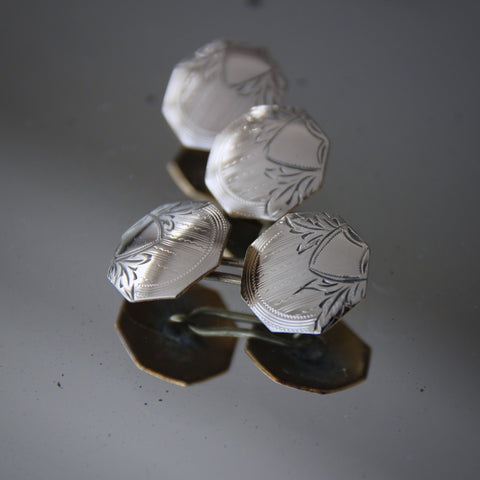This week we are showing a handful of handsome vintage cufflinks, recently unearthed—five years after being packed-up when we closed our Greenwich Village shop. See more cufflinks tomorrow and many more in our on-line shop.
I often find "silver-fronted" (or "gold-fronted") vintage cufflinks are England. It was a way for jewelers to present quality metalwork in an affordable manner. This goal—to make nicer things for less money—has always been the mission which drove industrial design and mass production.
It's helpful to remember that sewn-on buttons were not common or ordinary (for most people) until the early Twentieth Century. First of all, buttons were historically expensive—and played a featured role in promoting the wealth and status of the button wearer. There were times and places when buttons were taxed as luxury indulgences. During the Nineteenth Century, shirt (and collar) studs started to be made with increasingly affordable materials, using mass-production methods, which dramatically lowered their cost of purchase. But it wasn't until the Turn-of-the-Twentieth-Century that modern industrial production delivered inexpensive shirt buttons within reach of the common person. Shortly thereafter, World War One played a key role in acclimating most men to sewn-on buttons (in their military uniforms).
With this history in mind, we understand that cufflinks were not always considered "fine jewelry." Every man (prince or pauper) needed to use something to fasten his sleeves. And, until World War One, the most common closure was the cufflink. Some cufflinks were exquisite (for aristocrats), most cufflinks were utilitarian (for everyone else). In this era, cufflinks were not thought of as fancy dress. As the middle class grew, and industrial mass production lowered prices, designers were able to produce nice and affordable cufflinks.
Silver-fronted cufflinks involved bonding a layer of silver over a layer of base metal (with heat and pressure). These bonded sheets would then be cut or stamped to produce the cufflink "blanks" which would be further decorated and finished. In America, Krementz excelled in mass-producing very high quality cufflinks affordably using their proprietary "rolled gold" method. The result was a cufflink that looked like precious metal but was less expensive—and more durable, too.
The Edwardian English silver-fronted cufflinks, shown above, were made in the 1910's or 1920's. Click on the photo above to learn more about them.
More "missing links" tomorrow.
Though our Greenwich Village store is now permanently closed, LEO Design is still alive and well! Please visit our on-line store where we continue to sell Handsome Gifts (www.LEOdesignNYC.com).
We also can be found in Pittsburgh's historic "Strip District" at Mahla & Co. Antiques (www.mahlaantiques.com) or in Canonsburg, Pennsylvania at The Antique Center of Strabane (www.antiquecenterofstrabane.com).
Or call to arrange to visit our Pittsburgh showroom (by private appointment only). 917-446-4248


